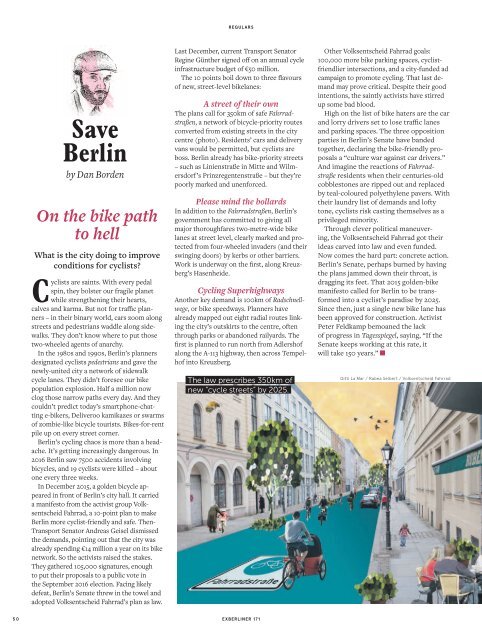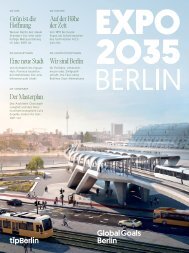Create successful ePaper yourself
Turn your PDF publications into a flip-book with our unique Google optimized e-Paper software.
REGULARS<br />
Save<br />
Berlin<br />
by Dan Borden<br />
On the bike path<br />
to hell<br />
What is the city doing to improve<br />
conditions for cyclists?<br />
Cyclists are saints. With every pedal<br />
spin, they bolster our fragile planet<br />
while strengthening their hearts,<br />
calves and karma. But not for traffic planners<br />
– in their binary world, cars zoom along<br />
streets and pedestrians waddle along sidewalks.<br />
They don’t know where to put those<br />
two-wheeled agents of anarchy.<br />
In the 1980s and 1990s, Berlin’s planners<br />
designated cyclists pedestrians and gave the<br />
newly-united city a network of sidewalk<br />
cycle lanes. They didn’t foresee our bike<br />
population explosion. Half a million now<br />
clog those narrow paths every day. And they<br />
couldn’t predict today’s smartphone-chatting<br />
e-bikers, Deliveroo kamikazes or swarms<br />
of zombie-like bicycle tourists. Bikes-for-rent<br />
pile up on every street corner.<br />
Berlin’s cycling chaos is more than a headache.<br />
It’s getting increasingly dangerous. In<br />
2016 Berlin saw 7500 accidents involving<br />
bicycles, and 19 cyclists were killed – about<br />
one every three weeks.<br />
In December 2015, a golden bicycle appeared<br />
in front of Berlin’s city hall. It carried<br />
a manifesto from the activist group Volksentscheid<br />
Fahrrad, a 10-point plan to make<br />
Berlin more cyclist-friendly and safe. Then-<br />
Transport Senator Andreas Geisel dismissed<br />
the demands, pointing out that the city was<br />
already spending €14 million a year on its bike<br />
network. So the activists raised the stakes.<br />
They gathered 105,000 signatures, enough<br />
to put their proposals to a public vote in<br />
the September 2016 election. Facing likely<br />
defeat, Berlin’s Senate threw in the towel and<br />
adopted Volksentscheid Fahrrad’s plan as law.<br />
Last December, current Transport Senator<br />
Regine Günther signed off on an annual cycle<br />
infrastructure budget of €50 million.<br />
The 10 points boil down to three flavours<br />
of new, street-level bikelanes:<br />
A street of their own<br />
The plans call for 350km of safe Fahrradstraßen,<br />
a network of bicycle-priority routes<br />
converted from existing streets in the city<br />
centre (photo). Residents’ cars and delivery<br />
vans would be permitted, but cyclists are<br />
boss. Berlin already has bike-priority streets<br />
– such as Linienstraße in Mitte and Wilmersdorf’s<br />
Prinzregentenstraße – but they’re<br />
poorly marked and unenforced.<br />
Please mind the bollards<br />
In addition to the Fahrradstraßen, Berlin’s<br />
government has committed to giving all<br />
major thoroughfares two-metre-wide bike<br />
lanes at street level, clearly marked and protected<br />
from four-wheeled invaders (and their<br />
swinging doors) by kerbs or other barriers.<br />
Work is underway on the first, along Kreuzberg’s<br />
Hasenheide.<br />
Cycling Superhighways<br />
Another key demand is 100km of Radschnellwege,<br />
or bike speedways. Planners have<br />
already mapped out eight radial routes linking<br />
the city’s outskirts to the centre, often<br />
through parks or abandoned railyards. The<br />
first is planned to run north from Adlershof<br />
along the A-113 highway, then across Tempelhof<br />
into Kreuzberg.<br />
The law prescribes 350km of<br />
new “cycle streets” by 2025.<br />
Other Volksentscheid Fahrrad goals:<br />
100,000 more bike parking spaces, cyclistfriendlier<br />
intersections, and a city-funded ad<br />
campaign to promote cycling. That last demand<br />
may prove critical. Despite their good<br />
intentions, the saintly activists have stirred<br />
up some bad blood.<br />
High on the list of bike haters are the car<br />
and lorry drivers set to lose traffic lanes<br />
and parking spaces. The three opposition<br />
parties in Berlin’s Senate have banded<br />
together, declaring the bike-friendly proposals<br />
a “culture war against car drivers.”<br />
And imagine the reactions of Fahrradstraße<br />
residents when their centuries-old<br />
cobblestones are ripped out and replaced<br />
by teal-coloured polyethylene pavers. With<br />
their laundry list of demands and lofty<br />
tone, cyclists risk casting themselves as a<br />
privileged minority.<br />
Through clever political maneuvering,<br />
the Volksentscheid Fahrrad got their<br />
ideas carved into law and even funded.<br />
Now comes the hard part: concrete action.<br />
Berlin’s Senate, perhaps burned by having<br />
the plans jammed down their throat, is<br />
dragging its feet. That 2015 golden-bike<br />
manifesto called for Berlin to be transformed<br />
into a cyclist’s paradise by 2025.<br />
Since then, just a single new bike lane has<br />
been approved for construction. Activist<br />
Peter Feldkamp bemoaned the lack<br />
of progress in Tagesspiegel, saying, “If the<br />
Senate keeps working at this rate, it<br />
will take 150 years.” ■<br />
Gitti La Mar / Rabea Seibert / Volksentscheid Fahrrad<br />
50<br />
EXBERLINER <strong>171</strong>

















